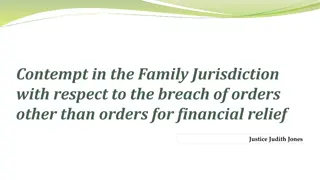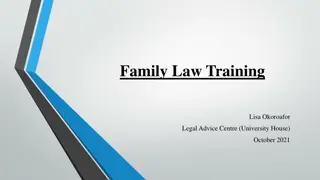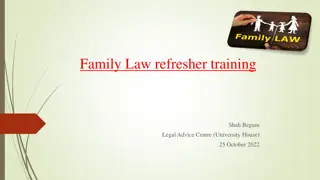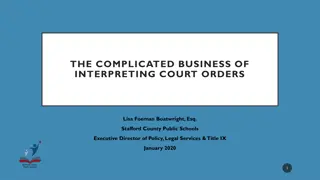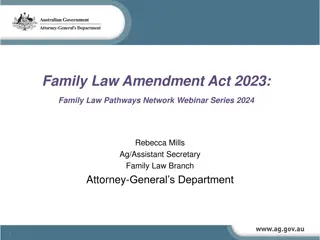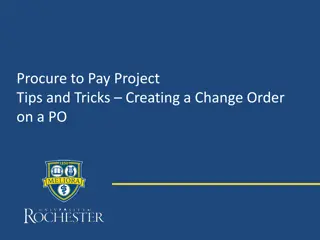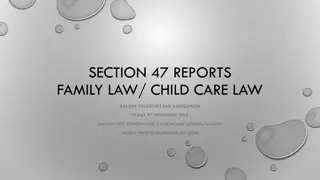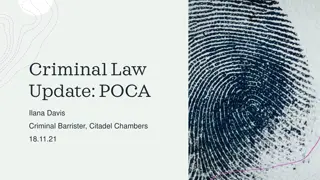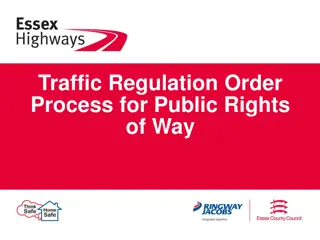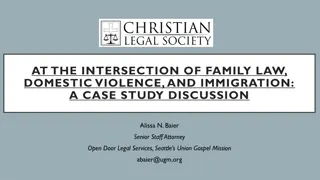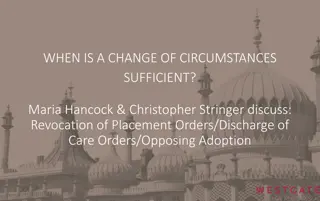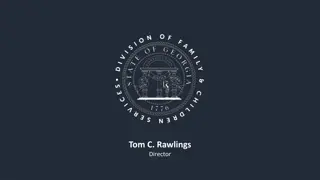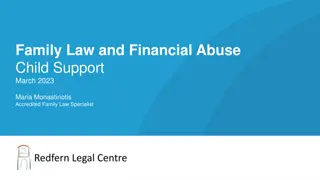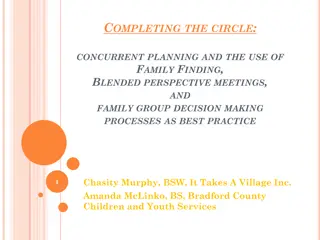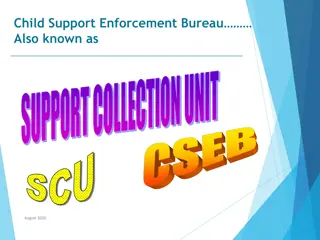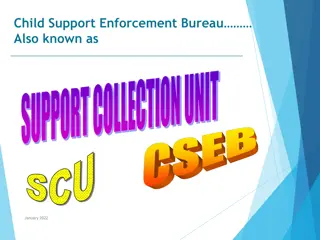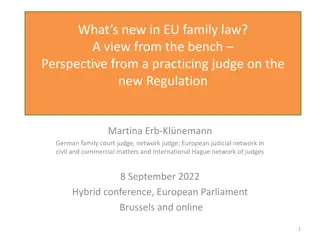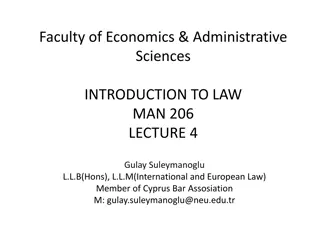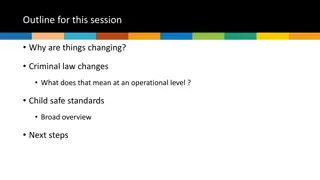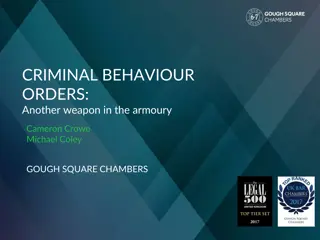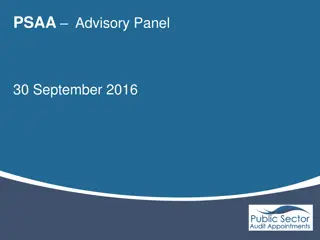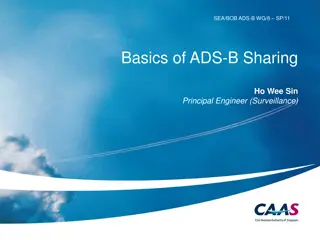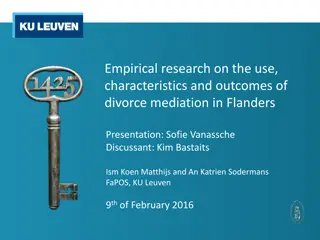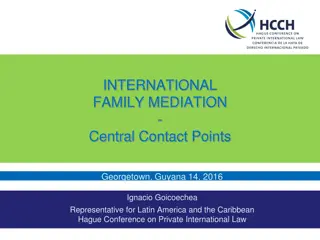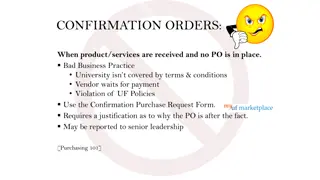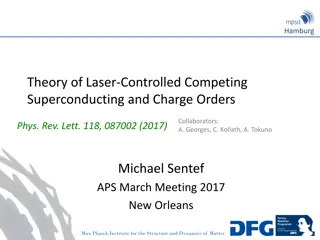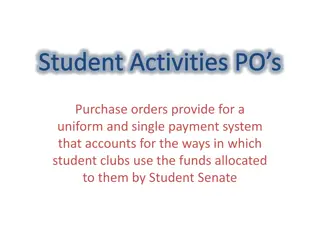Understanding Child Arrangements Orders in Family Law
This session on Family Law Training covers various types of court orders related to child arrangements, such as Child Arrangements Orders (CAO), Prohibited Steps Orders, and Specific Issue Orders. It explains who can apply for a CAO under the Children Act 1989 and the implications of non-compliance with the order. The training also delves into the process of making Section 8 applications at Family Proceedings Court or County Court.
Download Presentation

Please find below an Image/Link to download the presentation.
The content on the website is provided AS IS for your information and personal use only. It may not be sold, licensed, or shared on other websites without obtaining consent from the author. Download presentation by click this link. If you encounter any issues during the download, it is possible that the publisher has removed the file from their server.
E N D
Presentation Transcript
Family Law Training Lisa Okoroafor Solicitor Legal Advice Centre (University House) July 2023
This session will cover: Child Arrangements Order Non Molestation Order Occupation Orders
Section 8 Orders - Children Act 1989
Child Arrangements Order A Child Arrangements Order (CAO) is a court order that specifies matters such as with whom a child is to live and when. It may alternatively, or also, set out with whom a child is to have contact with and when, and what form that contact should take. An CAO s were previously known as Residence and Contact Orders. They are now referred to as CAO live with and spend time with Orders. If a CAO is not complied with, then there are sanctions that can be taken if there was no reasonable excuse not to comply with it. A CAO usually last until the child is 16, unless the court is satisfied that the circumstances of the case are exceptional. However, an existing order can be varied or discharged by a court when a child has turned 16. If the separated parents move back into the same household, the CAO expires after 6 months of cohabitation.
Other Section 8 Orders Prohibited Steps Order (PSO) - which is used to limit when certain parental rights and duties can be exercised, for example, preventing a child from being removed from their school or being taken abroad. Once a PSO is made the other parent is prevented from taking that step without the consent of the court. Specific Issue Order (SIO) - which is used for decisions relating to the child s care aside from contact and who they will live with (for example, the school the child will attend, whether the child should have medical treatment, whether a child can go on holiday abroad etc.) A Section 8 application can either be made at a Family Proceedings Court (a Magistrates Court) or at a County Court.
Who can apply for a CAO? Under Section 10 Children Act 1989, the following categories of people are entitled to make an application for a CAO without having to seek permission from the court: Anyone who has parental responsibility Anyone who holds a residence order in respect of the child Any party to a marriage or civil partnership where the child is a child of the family Anyone with whom the child has lived for at least three years The parent, guardian or special guardian of a child
Who can apply for a CAO? (2) Anyone who has obtained the consent of either: (i) The Local Authority if the child is in their care; (ii) Everyone who has parental responsibility for the child A Local Authority foster parent if the child has lived with the foster care parent for one year immediately preceding the application A relative of a child if the child has lived with the relative for a period of at least one year immediately preceding the application Others outside these categories will need to seek permission from the court to issue an application for a CAO. It is usually via this route that wider family members such as grandparents are able to apply for orders in respect of their grandchildren
Legal Principles The court will always give the following four principles the highest priority: Paramountcy principle (Section 1 CA) - The child s welfare is of paramount importance Presumption of continued parental involvement (Section 1(2A) CA) - presumption (unless the contrary is shown) that involvement of the parents in the life of the child concerned will further that child s welfare: No delay principle (Section 1 (2) CA ) - The court shall have regard to the general principle that any delay is likely to prejudice the welfare of the child. This places an onus on the court to ensure that any proceedings concerning the upbringing of a child are conducted as expeditiously as possible. There are occasions where a delay will be justified by the need to secure assessments such as a report under CA 1989, s 7. It is acknowledged that delay is not always prejudicial to the child's welfare. Delaying a decision to allow a period of monitored contact may be regarded as purposeful, and a proportionate interference with the rights of the parties.
Legal Principles (2) No Order principle (Section 1 (5) CA) - The court shall not make an Order unless it considers that doing so would be better for the children than making no Order at all. The court will not intervene and make an order unless it can be shown that it would be in the child s best interests to do so. It is important to remember that when a court is looking at issues relating to children, the judge has a discretion, bearing in mind always that the child s welfare is the court s paramount consideration. The no order principle does not create a presumption one way or the other but asks the court to consider whether there will be a benefit to the child if the order was made. It is intended that the principle will discourage unnecessary orders being made and to promote parental cooperation and agreement
Welfare Checklist What the court takes into consideration The court will also have regard to the following criteria, which is called the Welfare Checklist: Section 1 (3) CA 1989. The ascertainable wishes and feelings of the child concerned (considered in the light of the child s age and understanding) The child s physical, emotional and educational needs The likely effect on the child of any change in his/her circumstances The child s age, sex, background, and any other characteristic which the court considers relevant Any harm which the child has suffered or is at risk of suffering How capable each of the child s parents, and any other person in relation to whom the court considers the question to be relevant, is of meeting the child s needs The range of powers available to the court under the Children Act in the proceedings in question.
The Role of Children and Family Court Advisory and Support Service (CAFCASS) The Cafcass is an independent organisation tasked with looking after the interests of children involved in family proceedings. Cafcass work with children and their families and advises the court on what it considers to be in the children s best interests. In cases relating to CAO, Cafcass will usually carry out certain checks prior to the first hearing. This will involve them contacting the police and Local Authority to see if there are any known safeguarding or welfare concerns about the child(ren) involved. Cafcass will also usually speak to each parent (usually be telephone) to give them an opportunity to explain any safeguarding or welfare concerns which they have. Cafcass will then prepare a safeguarding letter; this is a short report which Cafcass make available to the court containing the outcomes of the safeguarding checks and any potential welfare issues which have been identified. The safeguarding letter is usually made available to the court at least three days prior to the hearing. At the first hearing the court will determine the future role of Cafcass in the proceedings. If there are no welfare concerns then a Cafcass officer may still be involved to try to assist the parties in coming to an agreement with minimal further court proceedings. If parents are unable to reach an agreement or there are welfare concerns then the Cafcass officer may be asked to carry out further work with the family and prepare a more detailed report on the welfare issues
The Role of Children and Family Court Advisory and Support Service (CAFCASS) (2) The Section 7 Report The court will often ask Cafcass to prepare a report which will assist in determining the outcome of a family court dispute. A Cafcass officer will prepare this report after meeting with both parties and the child (alone where possible and only if the child has sufficient maturity and understanding). This more detailed report is known as a Section 7 report. When writing a report the Cafcass officer will have specific regard to welfare checklist
The Role of Social Services Legal disputes concerning children are divided conceptually into private or public law Section 8 CAO (private children proceedings) / Section 31 care and supervision order (public children proceedings). The Local Authority is generally involved in public law children proceedings The Local Authority can become involved in private law proceedings in a variety of ways. 1.The Local Authority may have to provide a welfare report if there is current or recent involvement 2.The Court can make a Family Assistance Order requiring the Local Authority to assist a child or family in private law proceedings 3.Children in disputes may be Children in Need requiring support from the Local Authority 4.There may be referrals from CAFCASS following the safeguarding checks or other professionals with concerns 5.Children may be in need of protection and the court may make a section 37 order
The Role of Social Services (2) The court can order for the Local Authority to prepare a section 7 report as outlined above. The court can also order for the Local Authority to prepare a Section 37 report - which is an investigation of a child s circumstances if it appears to the court that it may be appropriate for a care or supervision order to be made.
Procedure - Part 12 Family Procedure Rules How to apply Mediation - Before an application can be made to the Family Court for a CAO, the parties must have attended a mediation information assessment meeting (unless an exemption applies). If the case is not suitable for mediation or it cannot progress the mediator will confirm this to allow the applicant to carry on and apply to the court. Legal Aid may be available for mediation if the applicant is on a low income. If mediation is successful, the parties will receive a document usually known as a memorandum of understanding. This agreement is not legally binding. It can only become binding if it is incorporated into a consent order and sealed by the Court.
Procedure - How to Apply (2) Fill in the C100 court form. The parties must show they have attended a meeting about mediation first, or exempt. A form C1A form is to be supplemented to the C100 form is there are allegations about the risk of harm in relation to the child. Send the original form and 3 copies of it to the nearest court that deals with cases involving children. Due to coronavirus (COVID-19), a C100 form will be processed faster if it is submitted online rather then sent by post. It costs 232 to apply for a section 8 order The party applying may be able to get help with court fees if the person is on benefits or a low income.
First Hearing Dispute Resolution Appointment (FHDRA) The court will arrange a directions hearing with both parents. There will usually be a family court adviser from CAFCASS at the hearing. Parties should receive a phone call from CAFCASS. At the hearing, a judge or magistrate will try to work out: what the parties can agree what they cannot agree if the child is at risk of harm CAFCASS will encourage the parties to reach an agreement if it s in the child s best interests. If the parties can, and there are no concerns about the child s welfare, the judge or magistrate can end the process. The court will make a final order which sets out what the parties agreed, if necessary.
First Hearing Dispute Resolution Appointment (FHDRA) (2) If the parties do not agree, CAFCASS will want to talk about any safeguarding concerns either party may have. They will also ask about what each party hopes to achieve from the proceedings. The investigations and conversations will form the basis of CAFCASS safeguarding letter to the Court for the 1st hearing which will have recommendations to the court on possible directions.
First Hearing Dispute Resolution Appointment (FHDRA) (3) The court will set a timetable for what happens next. The court may ask the parties to try again to reach an agreement, for example by going to a meeting with a mediator. The parties may be directed to go on a course. The course is called a Separated Parents Information Programme , and could help the parties find a way to make child arrangements work. The parties usually have to go to one or 2 meetings, depending on the type of programme. The parties will not be at the same meetings. If the parties reach an agreement at any stage, the court can stop the process.
Allegations of Domestic Abuse Where there are domestic abuse allegations that are denied then the Court should deal with this first and so is likely to direct both parties to file and serve statements dealing with the allegations. The court has to consider whether a fact finding hearing is necessary under practice direction 12J
Fact-finding hearing and Dispute Resolution Appointment (DRA) There will be a fact finding hearing once the statements and the Schedule of allegations are completed and when all police disclosure been received (if applicable). Usually both parties will have to give evidence so often this hearing can last half a day/ a day. The court will determine whether any allegations of domestic abuse have been proven. The court will then list the matter for a DRA. A DRA hearing will narrow the issues if possible and see if an agreement is possible. If there is no agreement at the DRA, the Court will fix a date for a final hearing.
Final Hearing In preparation for a final hearing the applicant will be expected to prepare an agreed, paginated and indexed bundle for use by the parties and the court. This will include all the papers and statements along with an up to date case summary, a chronology, statement of issues and a position statement. At the final hearing both parties will give their evidence and challenge the other parties evidence in cross examination. The Judge will then make an Order taking into account the Welfare Checklist.
Changes to the initial application or request for directions The parties should use form C2 to start an application in existing proceedings: The fee depends on what the parties are asking the court to do. Court fees: 167 if the parties still want the court to decide your case through a court hearing 53 if the parties have agreed and they want the court to approve their consent order without a court hearing
Enforcement / Variation / discharge Cases do return to Court perhaps for enforcement of any Order made or if the order needs to be varied in any way and the parties cannot agree. Enforcement - Section 11J Children Act 1989 Variation / discharge - Section 8 Children Act 1989
Non Molestation Order
Introduction Under Family Law Act 1996 (FLA 1996), an individual can apply for an injunction if they have been a victim of domestic abuse. An individual can apply for: A non-molestation order which protects the applicant and/or their child from being molested, harmed or threatened by the person who has abused them An occupation order which confers, declares, restricts or regulate rights of occupation in the family home between parties who are in, or who have been in, certain categories of relationship
When can a non-molestation order be granted? Under Family Law Act (FLA 1996) S42(2)(a) a non molestation order can only be granted to protect a person associated with the respondent or a relevant child. A person is associated with another person if: they are or have been married they are or have been civil partners they are cohabitants or former cohabitants they live or have lived in the same household otherwise than merely by reason of one being the other s employee, tenant, lodger or boarder this could include, for example, students. they are relatives they have agreed to marry one another they have entered into a civil partnership agreement, they have or have had an intimate personal relationship with each other that is or was of significant duration in relation to any child they are both either a parent or have parental responsibility for the child they are parties to the same family proceedings
Molestation There is no statutory definition of the term molestation. Therefore, guidance can be elicited from the case law. The leading case is Vaughan v Vaughan[1973] 3 All ER 449 where the court equated molestation with pestering . In C v C (Non-Molestation Order: Jurisdiction) [1998] 1 FLR 554 Sir Stephen Brown stated: 'there is no legal definition of 'molestation'. Indeed, that is quite clear from the various cases which have been cited. It is a matter which has to be considered in relation to the particular facts of particular cases. It implies some quite deliberate conduct which is aimed at a high degree of harassment of the other party, so as to justify the intervention of the court . Molestation involves any form of physical, sexual or psychological molestation or harassment that has a serious impact on the health and well-being of the applicant. Violence is not a prerequisite. Domestic violence and abuse is defined as any incident or pattern of incidents of controlling, coercive or threatening behaviour, violence, or abuse between those aged 16 or over who are, or have been, intimate partners or family members regardless of gender or sexuality. The abuse can encompass, but is not limited to, that which is: Psychological Physical Sexual Financial Emotional
The terms of a Non-Molestation Order From and after the time when the Respondent is made aware of the terms of this order whether by personal service or telephone or text message or social media or otherwise the Respondent whether by himself or acting jointly with any other person is forbidden to: Use or threaten violence against the Applicant; Threaten, intimidate, harass, verbally abuse or pester the Applicant in any way; Communicate with the Applicant, or anyone associated with him/her, whether by letter, telephone, text message, social media or other means of communication; Send any threatening or abusive letters, emails, text or voicemail messages to the Applicant or anyone associated with him/her; The Respondent must not damage, attempt to damage or threaten to damage any property (including any contents within any property) owned by or in possession or control of the Applicant; The respondent is also forbidden to instruct, encourage or in any way suggest that any other person to do anything which he is forbidden to do by the terms of this Order. This order shall remain in force until 4:00pm on the order of the court. unless before then it is varied or discharged by an
The terms of a Non-Molestation Order (2) Exclusion zones When making a non-molestation order the court can include a stay away clause providing for an exclusion zone. The order may provide eg that one part must not go within 100 meters of where the party lives. Such a provision in a non-molestation order must be proportionate and necessary and supported by evidence and should not be routinely included in such orders. In R v R (Family Court: Procedural Fairness)[2014] EWFC 48 - the court held that extra injunctive provisions such as exclusion areas and orders prohibiting any direct communication between parties should not be routinely included in non-molestation orders. They are serious infringements of a person's freedom of action and require specific evidence to justify them. An order that requires a party to leave a property cannot form part of a non-molestation order and can only be made as part of an occupation order. If the court is considering applications for both a non-molestation order and an occupation order and makes both types of order the orders must each be drawn up separately.
How does the court decide whether to make a Non-Molestation Order? The court has a wide discretion whether to grant or refuse the relief sought. FLA 1996 S42(5) states that in deciding whether to make an order the court needs to consider all of the circumstances of the case including the health, safety and well-being of the applicant and any child or children. The court in C v C (Non-Molestation Order: Jurisdiction) established three principles that should be considered by the court when considering whether to grant the order: there must be evidence of molestation going on the applicant or child must need protection the judge must be satisfied that judicial intervention is required to control the respondent s behaviour Health includes physical and mental health. There is no definition regarding safety or well-being.
How long do Non-Molestation Orders last? Non molestation orders normally last for a specific period of time often 6 months or a year. An Order made on a without notice application may be limited up to the date of the return hearing (usually within 7-14 days ) by which time the respondent will have been served with the without notice order. The respondent will be aware of the terms of the order and invited to attend the return hearing. When a final order is made it can be for an indefinite period but this is rare.
What are the consequences of breaching a Non-Molestation Order? A breach of a non-molestation order is a criminal offence so if the respondent breaches one or more of the terms, the respondent can be arrested and brought before a criminal court. The respondent could be remanded in custody depending upon the seriousness of the breach. If this happens the applicant will be treated as a witness and will not have their own legal representation in the criminal court; the police and the Crown Prosecution Service (CPS) will pursue the prosecution against the respondent. A person found guilty of an offence of breaching a non-molestation order can be liable: on conviction on indictment, to imprisonment for a term not exceeding five years, or a fine, or both; on summary conviction, to imprisonment for a term not exceeding 12 months, or a fine not exceeding the statutory maximum, or both.
Application process - Part 10 family procedure rules The application form FL401 should accompany a comprehensive statement explaining why there is a genuine need for a protective injunction. The court will consider the evidence provided by the applicant and will decide whether an order is necessary and, if so, the terms of the order to ensure that the health, safety and welfare of the applicant (and any child) are maintained. A statement should begin with brief background, it should convey an accurate timeline of events, including the first, the worst and the most recent incidents of domestic abuse. There is no Court fee for non-molestation order applications. An application can be made with or without notice. FLA 1996 s45 is to be considered if a without notice application is to be made. A draft order should be lodged when the application is issued. Download and fill in form C8 if the applicant wants to keep their address private. Email or send all the documents to the applicant s local court that deals with domestic abuse cases.
Court Hearings Without notice hearing (if an application has been made without notice) Return Hearing or On notice hearing (if an application has been made on notice) Final Hearing
An occupation order is an order made under section 33-38 FLA 1996 If a couple cannot agree what to do with a property following a relationship breakdown, they will have to apply to the court to resolve the situation. In the short term, the court can make an occupation order under the FLA1996 setting out, for example, who can live at the property or ordering one of the spouses or civil partners to leave. Occupation orders are only a short-term solution and will not affect what happens to the property in the final financial remedy settlement. Occupation orders can only be made in relation to a dwelling-house. A dwelling-house for this purpose includes: any building or part of a building which is occupied as a dwelling any caravan, houseboat or structure which is occupied as a dwelling, and any yard, garden, garage or outhouse belonging to the above and occupied with it
Categories of application Occupation orders can be made under five different sections of FLA 1996 detailing distinct sets of circumstances. The extent of the court s powers depends on the eligibility of the applicant, their relationship with the respondent and the status of the dwelling-house. It is therefore important that the application and order is made under the correct section of FLA 1996. As a first step the category that the applicant falls into should be ascertained so as to establish the type of order that may be made and the criteria that will be applied. Note that if an application is made under the incorrect section, the court has the power to remedy the defect The categories of applicant are: applicant has an estate, interest or home rights in the dwelling-house (Section 33) applicant is a former spouse or former civil partner with no existing right to occupy (Section 35) applicant is a cohabitant or former cohabitant with no existing right to occupy (Section 36) where neither spouse or civil partner are entitled to occupy (Section 37) where neither cohabitant or former cohabitant are entitled to occupy (Section 38)
Categories of application (2) The Marriage (Same Sex Couples) Act 2013 - provides that, with effect from 13 March 2014, where there are references to a marriage, a married couple or a married person in existing legislation in England and Wales, these are to be read as also referring to a marriage of a same-sex couple, a married same-sex couple or to a person married to someone of the same sex.
Applicant who has an estate, interest or home rights in a dwelling-house Section 33 Is the widest in scope of the sections The applicant is entitled to occupy a property termed a dwelling-house The respondent is associated The house must be, have been, or have been intended to be, the home of the applicant and respondent The court must consider the balance of harm test in Section 33(7) FLA 1996 before considering the discretionary criteria in Section 33(6) FLA 1996
Balance of Harm Test and Discretionary Criteria Balance of harm test If it appears to the court that the applicant or any relevant child is likely to suffer significant harm attributable to the conduct of the respondent if an order is not made, it is mandatory for the court to make an occupation order unless it appears that the respondent or any relevant child is likely to suffer significant harm if the order is made and that harm is as great or greater than the harm likely to be suffered by the applicant. This is known as the balance of harm test. Discretionary criteria If the court determines that neither the applicant or the relevant child is likely to suffer significant harm attributable to the conduct of the respondent, it enters the discretionary regime. The criteria to be applied in deciding whether to exercise its powers include: the housing needs and housing resources of each of the parties and of any relevant child the financial resources of each of the parties the likely effect of any order, or decision not to exercise powers, on the health, safety or well-being of the parties and any relevant child the conduct of the parties
Orders available under Section 33 FLA 1996 The court may make orders that: enforce the applicant s entitlement to remain in occupation as against the respondent require the respondent to permit the applicant to enter and remain in the dwelling-house or part of the dwelling-house regulate the occupation of the dwelling-house by either or both parties prohibit, suspend or restrict the respondent s right to occupy the dwelling-house restrict or terminate the respondent s home rights in relation to the dwelling-house require the respondent to leave the dwelling-house or part of the dwelling-house exclude the respondent from a defined area in which the dwelling-house is included
Ancillary Orders (Section 40 FLA 1996) Where an occupation order is made under FLA 1996 s33, s35 or s36, the court has the power to impose obligations on either party. These obligations include payments towards the rent, mortgage or other outgoings, repair and maintenance. Furthermore, the court can grant either party possession or use of furniture or contents of the dwelling-house and order either party to take reasonable care of furniture. The additional provisions cannot last longer than the occupation order itself. The court shall have regard to all the circumstances of the case including: the financial needs and other resources of the parties the financial obligations that they have or are likely to have in the foreseeable future, including obligations to each other and to any relevant child In Nwogbe v Nwogbe [2000], the Court of Appeal held that an order made under Section 40 FLA 1996 requiring a man to make payments in respect of rent and other outgoings relating to the property could not be enforced. The man had failed to make the required payments and the woman sought to have him committed to prison for contempt.
What are the consequences of breaching an Occupation Order? The process for enforcing the order varies depending on whether a power of arrest is attached to the order. A power of arrest allows police officers to arrest the respondent if the occupation order is breached. Powers of arrest can be attached to occupation orders if the court is satisfied that your abuser has used or threatened violence against you. If your abuser breaches any part of your occupation order and there is a power of arrest attached to it, you can report the breach directly to the police. The police can arrest him and take him to the court that made the order to be punished. The court may hear evidence about the breach and deal with the respondent immediately, or the court may adjourn the hearing to another day. If your occupation order does not have a power of arrest attached, you can still apply to the court that made the order to have your abuser arrested and / or punished, if he has breached any part of the order. A respondent who is found by the court to have breached the order may be committed to prison, fined or be given a suspended sentence of imprisonment. The procedure in relation to applications and proceedings for committal for contempt of court is governed by Family Procedure Rules 2010 part 37 and the accompanying practice direction 37A.
Application process Check if the applicant is eligible to apply for an occupation order. The application form FL401 should accompany a comprehensive statement explaining why there is a genuine need for an occupation order. The court will consider the evidence provided by the applicant and will decide whether an order is necessary. There is no Court fee for occupation order applications. An application can be made with or without notice. FLA 1996 s45 is to be considered if a without notice application is to be made. A draft order should be lodged when the application is issued. Download and fill in form C8 if the applicant wants to keep their address private. Email or send all the documents to the applicant s local court that deals with domestic abuse cases.
Service of application and supporting documents The applicant must arrange for a copy of their application and witness statement to be served on the respondent. The applicant s solicitor will arrange a process server or if the applicant is acting in person they can ask the court to serve the documents. The applicant should not serve the documents themselves.
Duration of an Occupation Order At the court's discretion, occupation orders can last: Indefinitely For a certain length of time, or Until a specific event occurs, such as a divorce In practice it is unlikely to be for more than 6 months.
Thank you for listening. Lisa Okoroafor Lisa@legaladvicecentre.london


